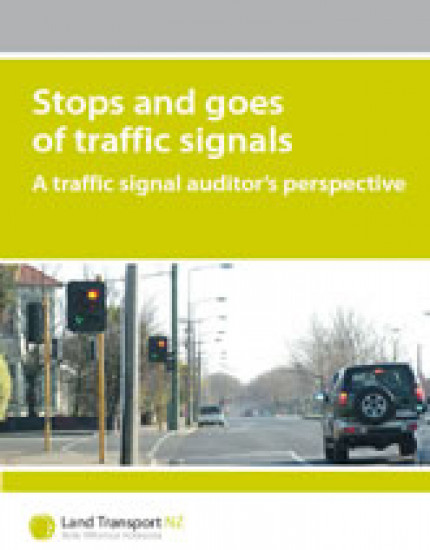6. Signal post and display location
6.1 Post placement and signal conspicuity
Signal faces provide one or more of four functions. Motorists get information that warns them, makes them stop, indicates when to start again and indicates what manoeuvres can be undertaken. Safety is reduced if signal faces are not clearly visible from the appropriate distance.
One of the most common safety audit findings was that of signals with inadequate conspicuity. When
this lack of conspicuity includes the signal faces that perform the warning and stopping functions,
safety is reduced as a consequence.
Safety and efficiency issues
Poor post placement and reduced signal conspicuity can lead to:
- an increase in inadvertent red light running
- an increase in rear-end crashes
- an increase in right-turn-against crashes
- reduced efficiency.
Recommended treatments
- RCAs should have an upgrading programme for conversion to tall (5 m) posts or mast arms as
appropriate.
- Kerbside posts should be located nominally 1 m (and no less than 0.6 m) from the kerb face, and close to the tangent point. Minimising corner radii can help achieve this.
- Kerb extensions should be used wherever possible to improve lantern visibility.
- Street furniture should not reduce signal conspicuity. Under-grounding aerial services, locating street lighting poles at the property boundary and using joint-use poles can all be considered. The size of trees must be taken into account both at the time of planting and at maturity, and ongoing maintenance (pruning, trimming) allowed for.
Figure 7 No signals visible to approaching drivers
Figure 8 Good conspicuity of traffic signals
6.2 Sufficient stopping and manoeuvring displays
Motorists must receive the relevant information from signal displays, regardless of the lane they
are travelling in. Some redundancy has to be designed into the system, as lamps can fail and the
remaining signals must still provide a safe intersection. Legislated minimum requirements also need to
be met.
Safety and efficiency issues
An insufficient number of signal displays can lead to:
- compromised signal conspicuity (for motorists in some traffic lanes, for example, caused by large vehicles in adjacent lanes) and thus reduced safety
- motorists making wrong choices
- unsafe intersection operation in case of lamp failure
- RCAs opening themselves to avoidable risks when legislated requirements are not met.
Recommended treatments
- One of each type of display must be provided on an approach in the primary or dual primary
position (including arrow displays).
- The minimum number of signal displays for major and minor movements is three and two,
respectively. A major movement is one where the associated displays do not have an OFF state.
Therefore, a right or left-turning movement that is allowed to filter is a minor movement, but a
right-turning movement that is fully protected (at least during certain time periods) is classed as a
major movement.
- Signal faces provide one or more of four functions (warning, stopping, starting and/or
manoeuvring). One signal face does not adequately provide the function if two or more lanes of
traffic separate approaching vehicles and the signal face.
- At least one aspect must be illuminated in any one signal face at any one time (ie, avoid signal faces with three arrow aspects only where filter turning occurs, as all aspects will be in the OFF state during filter turning).
Figure 9 Non-complying two-aspect display (green missing)
Figure 10 Fully protected right turn with the required three right-turn arrow displays
< previous | next >




